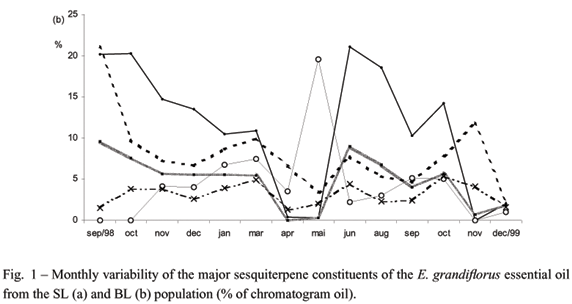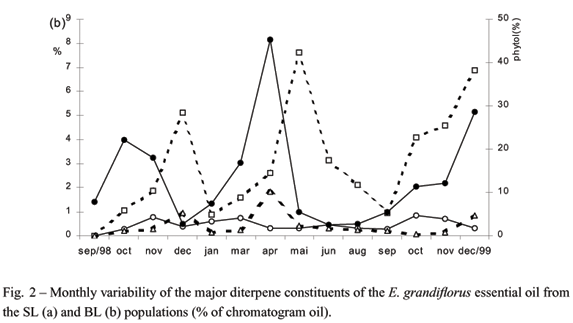Abstracts
Analysis by Gas Chromatography and Gas Chromatography/Mass Spectrometry of the essential oils obtained from leaves of Echinodorus grandiflorus ("Chapéu de couro") from two different populations (Big Leaves and Small Leaves), collected monthly between September 1998 and December 1999 revealed 17 components. Phytol was the major constituent for both populations. The main sesquiterpene representatives are (E)-caryophyllene, alpha-humulene and (E)-nerolidol.
Echinodorus grandiflorus; Alismataceae; essential oil; sesquiterpenes; diterpenes
Análise por cromatografia com fase gasosa e cromatografia com fase gasosa acoplada à espectrometria de massas de óleos essenciais obtidos de folhas de Echinodorus grandiflorus ("Chapéu-de-couro") em duas diferentes populações (folhas grandes e folhas pequenas), coletadas mensalmente entre setembro de 1998 e dezembro de 1999, revelou 17 componentes. Fitol foi o constituinte majoritário em ambas populações. Os principais representantes sesquiterpênicos foram (E)-cariofileno, alfa-humuleno e (E)-nerolidol.
Echinodorus grandiflorus; Alismataceae; óleo essencial; sesquiterpenos; diterpenos
CHEMICAL SCIENCES
Essential oil from two populations of Echinodorus grandiflorus (Cham. & Schltdl.) Micheli (Chapéu de couro)
Daniel S. PimentaI; Maria Raquel FigueiredoII; Maria Auxiliadora C. KaplanIII
ILaboratório de Produtos Naturais, PN3, Far-Manguinhos, FIOCRUZ, Rua Sizenando Nabuco, 100, 21041-250 Rio de Janeiro, RJ, Brasil
IIDepartamento de Botânica, Instituto de Ciências Biológicas, UFJF, Campus Universitário, 36036-330 Juiz de Fora, MG, Brasil
IIINúcleo de Pesquisas de Produtos Naturais, UFRJ, Cidade Universitária, 21941-900 Rio de Janeiro, RJ, Brasil
ABSTRACT
Analysis by Gas Chromatography and Gas Chromatography/Mass Spectrometry of the essential oils obtained from leaves of Echinodorus grandiflorus ("Chapéu de couro") from two different populations (Big Leaves and Small Leaves), collected monthly between September 1998 and December 1999 revealed 17 components. Phytol was the major constituent for both populations. The main sesquiterpene representatives are (E)-caryophyllene, a-humulene and (E)-nerolidol.
Key words:Echinodorus grandiflorus, Alismataceae, essential oil, sesquiterpenes, diterpenes.
RESUMO
Análise por cromatografia com fase gasosa e cromatografia com fase gasosa acoplada à espectrometria de massas de óleos essenciais obtidos de folhas de Echinodorus grandiflorus ("Chapéu-de-couro") em duas diferentes populações (folhas grandes e folhas pequenas), coletadas mensalmente entre setembro de 1998 e dezembro de 1999, revelou 17 componentes. Fitol foi o constituinte majoritário em ambas populações. Os principais representantes sesquiterpênicos foram (E)-cariofileno, a-humuleno e (E)-nerolidol.
Palavras-chave:Echinodorus grandiflorus, Alismataceae, óleo essencial, sesquiterpenos, diterpenos.
INTRODUCTION
Alismataceae is a primitive monocotyledonous family comprising 11 genera and 75 species occurring in tropical, subtropical and subtemperate regions in the Eastern as well as the Western Hemisphere (Crow 2003). These plants are aquatic or semi-aquatic herbs with milky sap. Of the two largest genera, Echinodorus is restricted to the neotropics, native in tropical America and it is formed by 26 species that occur from northern United States to Patagonia (Haynes and Nielsen 1994). In Brazil E. grandiflorus and E. macrophyllus are popularly known as "chapéu de couro". These plants have been used in the folk medicine as anti-inflammatory and diuretic. The chemical profile of Echinodorus species is represented basically by terpenoids (Manns and Hartmann 1993, Tanaka et al. 1997, Costa et al. 1999, Kobayashi et al. 2000a, b).
This paper aims to describe the leaf essential oils from two populations of E. grandiflorus.
MATERIALS AND METHODS
COLLECTION OF PLANT MATERIAL
Leaves of E. grandiflorus were collected monthly from September 1998 to December 1999, (except in February and July) in Tanguá, Rio de Janeiro State, Brazil. The plants have been cultivated in two different places in the area resulting in two morphologically distinct populations: one showing exuberant big leaves (BL), growing on the sandy bed of an irrigation ditch and the other, with scrubby small leaves (SL), occurring on a clayish bank formerly used as a decantation lake for fluorite mining residues. The mean of leaf dry weight along the fourteen months of collection was 4.0 g and 1.2 g respectively for BL and SL. Leaves of the specimens from the two populations were always harvested in the morning by 10.00 o'clock. The botanical materials were identified by the botanist Dr. Erika Santos Guimarães as Echinodorus grandiflorus (Chamisso and Schlechtendal) Micheli, and the vouchers are found at the Herbarium CESJ, Universidade Federal de Juiz de Fora, Juiz de Fora, MG, under the register number 30.707.
ISOLATION OF THE OILS
About 3.00h after the collection the freshly picked leaves were hydrodistilled in a Clevenger-type apparatus (Gottlieb and Magalhães 1960) for 1.30h. The obtained oils were stored at -18ºC to be analyzed.
GAS CHROMATOGRAPHIC ANALYSES, GC
Capillary gas chromatography was performed using a Hewlett-Packard 6890 gas chromatograph; fused silica capillary column HP-5 (5% diphenyl and 95% dimethylpolysyloxane, 60m × 0,25mm, 0,25µm film thickness); helium as carrier gas; and temperature programming from 70ºC to 290ºC (2ºC/min); injector temperature 270ºC and detector temperature 300ºC.
GAS CHROMATOGRAPHY / MASS SPECTROMETRY, GC/MS
This analysis was carried out using a Hewlett-Packard 6890 gas chromatograph equipped with a fused silica capillary column (HP-5, 30m × 0.25mm, 0.25µm film thickness), helium as carrier gas with a flow rate 1.0ml/min; temperature programming from 70ºC to 290ºC (2ºC/min), coupled to a Hewlett-Packard 5972 mass spectrometer. The MS operating parameters were: 70eV, ion source 250ºC equipped with EI.
IDENTIFICATION OF THE OIL COMPONENTS
The compound identifications were carried out by comparison of their retention indices (RI) with literature values; and the MS data with those from Wiley 275.1 mass spectral data base besides literature records (Adams 1995).
RETENTION INDICES (RI)
These indices were calculated using a GC data of a homologous series of saturated aliphatic hydrocarbons within C8 to C22, performed at the same column and conditions as used in the GC analysis for the essential oils.
RESULTS AND DISCUSSION
The identified constituents of E. grandiflorus essential oils for the two analyzed populations (BL and SL) are shown in Tables I and II respectively, as well as with their percentage monthly recorded in GC analyses for the period September 1998 to December 1999, except in February and July. Both tables also show for each compound the mean percentage of oils, the mean retention time (RT) and the mean calculated retention indices (RI) as well as the literature RI recorded. Considering the relative area percentage, the total identified compounds was 58.9% for the BL and 60.3% for SL populations, being 39.9% / 32.0% due to mono- and sesquiterpenes and 19.0% / 28.3% to diterpenes for BL and SL populations respectively. Analyses of these tables show for the two populations phytol as the major oil constituent. The other significant sesquiterpene oil components are (E)-caryophyllene, (E)-nerolidol and a-humulene. Figures 1a and 1b shows the variability of the major sesquiterpene constituents from September 1998 to December 1999, for the two populations and (E)-caryophyllene showed to be the most representative product although for the BL population it has been closely followed by (E)-nerolidol.
The relative percentages of diterpenes in the E. grandiflorus essential oils for the two populations (Figures 2a and 2b) besides the production of huge amount of phytol, the presence of echinoic acid as the second major component must be mentioned since it has followed the phytol variability during the fourteen months in study. The diterpenes have been biosynthesized in greater amount by the BL-population except phytol that is produced 1.6 times more by the SL-population. Comparison of variability of the two major components in the E. grandiflorus oils, phytol and (E)-caryophyllene, through the fourteen months of study, seems to have a substitutive production (Figures 1 and 2).
This exuberant phytol production is of great value since this compound has been responsible for some recorded important biological activities (Pongprayoon et al. 1992, Rajab et al. 1998) which may indicates E. grandiflorus as a potential plant source for phytopharmaceuticals. In conclusion, it is worth to point out that the prominent production of phytol in both populations may characterize this compound as a chemotaxonomic marker for this plant species.
ACKNOWLEDGMENTS
The authors wish to thank Erika S. Guimarães/USP for species identification, Coordenação de Aperfeiçoamento de Pessoal de Nível Superior (CAPES), Conselho Nacional de Desenvolvimento Científico e Tecnológico (CNPq), Fundação Oswaldo Cruz (FIOCRUZ) for financial support and Far-Manguinhos Analytical Center for chromatograms.
Manuscript received on July 27, 2005; accepted for publication on May 2, 2006; contributed by MARIA AUXILIADORA C. KAPLAN*
* Member Academia Brasileira de Ciências
Correspondence to: Daniel Sales Pimenta
E-mail: dsp@icb.ufjf.br
- ADAMS RP. 1995. Identification of essential oil components by gas chromatography/mass spectroscopy, Illinois: Allured Publishing Corporation, 469 p.
- COSTA M, TANAKA CMA, IMAMURA PM AND MARSAIOLI AJ. 1999. Isolation and synthesis of a new clerodane from Echinodorus grandiflorus Phytochemistry 50: 117-122.
- CROW GE. 2003. Alismataceae: In: Manual de Plantas de Costa Rica, HAMMEL BE, GRAYUM MH, HERRERA C AND ZAMORA N (Eds), Monographs in Systematic Botany 92, St Louis: Missouri Botanic Garden, p. 35-42.
- GOTTLIEB OR AND MAGALHÃES MT. 1960. Modified distillation trap. Chemist-Analyst 49: 114.
- HAYNES RR AND NIELSEN LBH. 1994. Flora Neotropica - Monograph 64 - The Alismataceae, New York: New York Botanical Garden, 105 p.
- KOBAYASHI J, SEKIGUCHI M, SHIGEMORI H AND OHSAKI A. 2000a. Chapecoderins A-C, new labdane-derived diterpenoids from Echinodorus macrophyllus. J Nat Prod 63: 375-377.
- KOBAYASHI J, SEKIGUCHI M, SHIGEMORI H AND OHSAKI A. 2000b. Echinophyllins A and B, novel nitrogen-containing clerodane diterpenoids from Echinodorus macrophyllus. Tetrahedron Lett 41: 2939-2943.
- MANNS D AND HARTMANN R. 1993. Echinodol: a new cembrene derivative from Echinodorus grandiflorus. Planta Medica 59: 465-466.
- PONGPRAYOON N, BAETSTROM P, JACOBSSON U, LINDSTROM M AND BOHLIN L. 1992. Antispasmodic activity of b-damascenone and E-phytol isolated from Ipomoea pes-caprae Planta Medica 58: 19-21.
- RAJAB MS, CANTRELL CL, FRANZBLAU SG AND FISCHER NH. 1998. Antimycobacterial activity of (E)-phytol and derivatives: a preliminary structure-activity study. Planta Medica 64: 2-4.
- TANAKA CMA, SARRAGIOTTO MH, ZUKERMAN-SCHPECTOR J AND MARSAIOLI AJ. 1997. A cembrane from Echinodorus grandiflorus Phytochemistry 44: 1547-1549.
Publication Dates
-
Publication in this collection
28 Nov 2006 -
Date of issue
Dec 2006
History
-
Accepted
02 May 2006 -
Received
27 July 2005







